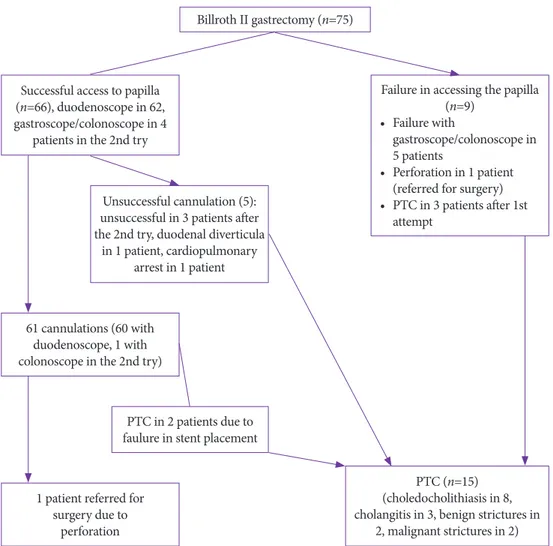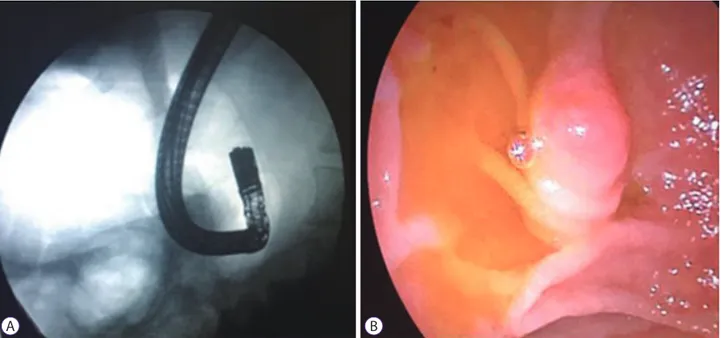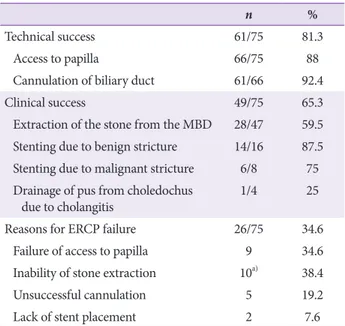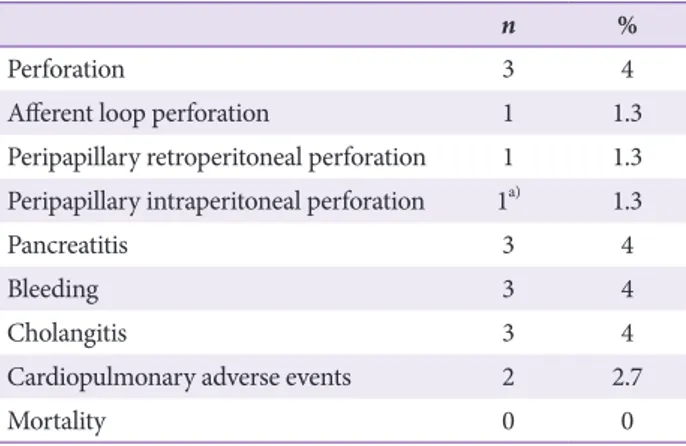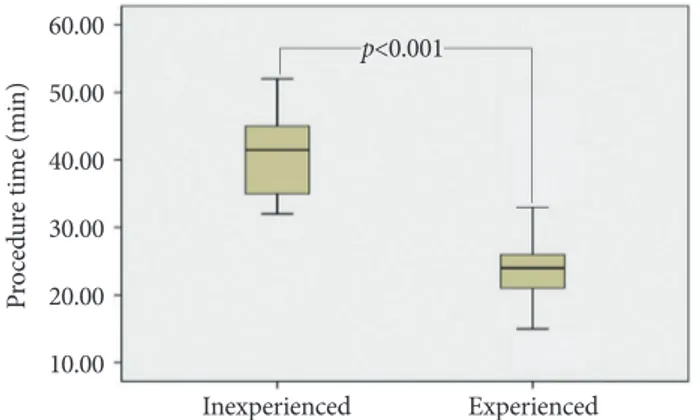Clin Endosc 2020;53:82-89 https://doi.org/10.5946/ce.2019.073
Print ISSN 2234-2400 • On-line ISSN 2234-2443
Experience of the Endoscopists Matters in Endoscopic Retrograde
Cholangiopancreatography in Billroth II Gastrectomy Patients
Erkan Caglar1, Deniz Atasoy2, Mukaddes Tozlu3, Engin Altınkaya1, Serkan Dogan1 and Hakan Senturk41Department of Gastroenterology, Kayseri Training and Education Hospital, Kayseri, 2Department of General Surgery, İstinye University,
Gaziosmanpasa Medical Park Hospital, Istanbul, 3Department of Gastroenterology,Sakarya University Medical Faculty, Sakarya, 4Department of Gastroenterology, Faculty of Medicine, Bezmialem University, Istanbul, Turkey
Background/Aims: Altered anatomy is a challenge in endoscopic retrograde cholangiopancreatography (ERCP) for patients with
Billroth II anastomosis. In this study, we investigated the overall success and role of endoscopist experience.
Methods: Data of patients who underwent ERCP between 2014 and 2018 after a previous Billroth II operation were retrieved
retrospectively from 2 tertiary ERCP centers. The procedures were performed by 2 endoscopists with different levels of experience. Clinical success was defined as extraction of the stone, placement of a stent through a malignant stricture, and clinical and laboratory improvements in patients.
Results: Seventy-five patients were included. The technical success rate was 83% for the experienced endoscopist and 75% for the
inexperienced endoscopist (p=0.46). The mean (±standard deviation) procedure time was 23.8±5.7 min for the experienced endoscopist and 40.68±6.07 min for the inexperienced endoscopist (p<0.001). In total, 3 perforations (4%) were found. The rate of afferent loop perforation was 6.25% (1/16) for the inexperienced endoscopist and 0% (0/59) for the experienced endoscopist (p=0.053).
Conclusions: ERCP in patients who had undergone Billroth II gastrectomy was time consuming for the inexperienced endoscopist
who should beware of the unique adverse events related to ERCP in patients with altered anatomy. Clin Endosc 2020;53:82-89
Key Words: Complication; Endoscope; Endoscopic retrograde cholangiopancreatography; Gastrectomy Open Access
IntRoduCtIon
Endoscopic retrograde cholangiopancreatography (ERCP) is widely used in the management of pancreatobiliary diseas-es. Compared to patients with a normal anatomy, those with an altered anatomy pose inconveniences and risks of visu-alization and cannulation of the papilla of Vater. Decreased
cannulation success rates and increased complication rates are reported in patients undergoing Billroth II operation.1,2
Various endoscopic techniques using forward-viewing en-doscopes, pediatric colonoscopes, single- or double-balloon enteroscopes, and cap-assisted endoscopes have been de-scribed.1,3-5 The advantages of using the duodenoscope,
includ-ing the presence of an elevator and a large workinclud-ing channel, side view of the lumen, and for others, the necessity for longer accessories, make it the first choice even for patients with an altered anatomy.6
We aimed to investigate the safety and efficacy of perform-ing ERCP with a side-viewperform-ing endoscope in patients who had undergone a Billroth II operation and to assess the role of en-doscopist experience.
Received: March 28, 2019 Revised: July 10, 2019 Accepted: July 23, 2019
Correspondence: Hakan Senturk
Department of Gastroenterology, Faculty of Medicine, Bezmialem University, İskender Paşa Mahellesi, Adnan Menderes Bulvarı, Fatih/İstanbul 34093, Turkey tel: +90-532-312-83-40, Fax: +90-212-231-03-74, E-mail: drhakansenturk@ya-hoo.com
oRCId: https://orcid.org/0000-0002-2440-4478
cc This is an Open Access article distributed under the terms of the Creative Commons Attribution Non-Commercial License (http://creativecommons.org/ licenses/by-nc/3.0) which permits unrestricted non-commercial use, distribution, and reproduction in any medium, provided the original work is properly cited.
Caglar E et al. ERCP in Billroth II
MAtERIAls And MEthods
Patients
Data of patients who underwent Billroth II gastrectomy for whom ERCP was performed between 2014 and 2018 in two endoscopy centers were retrieved. The exclusion criteria were as follows: (1) age of <18 years, (2) normal anatomy, (3) previous ERCP, and (4) other gastrointestinal alterations (e.g., Roux-en-Y). In both centers, ERCPs were performed by 2 endoscopists with different levels of experience (HS, with >200 ERCPs per year, and EC, with <200 ERCPs per year). Informed consent was obtained from all patients.
The upper gastrointestinal tract was first assessed with a front-viewing endoscope. ERCP procedures were performed under fluoroscopy using the Fujinon (DUO-XL; Fujifilm, kyo, Japan) and Pentax devices (ED 3680 TK 4.8; Pentax, To-kyo, Japan). In case of failure with the duodenoscope, the sec-ond or third attempts were performed 2 or 3 days later with a gastroscope (EG-250; Fujifilm) or pediatric colonoscope (EC-530 LS; Fujifilm). The flowchart of the 75 patients who had
undergone Billroth II gastrectomy is shown in Fig. 1. Sedation of patients was achieved using propofol, or midazolam and pethidine.
First, all the patients were placed in the left lateral decubitus position. After intubation, the patients were placed in a supine position. Formation of air enterogram in the blind loop and the tip of the endoscope were used as a guide to reach the af-ferent loop (Fig. 2).
For cannulation, a 0.035-in guidewire (Microtech, Nanjing, China) and a 5.5-F loaded catheter (tapered-tip ERCP cannu-la; Boston Scientific, Natick, MA, USA) were used as the first step. In case of failure, precut sphincterotomy (Fusion; Cook Medical, Winston-Salem, NC, USA), an antegrade technique (n=1 patient), and a double guidewire technique were used.
In patients with failure in the first attempt with the duode-noscope, a second attempt was performed with a gastroscope or pediatric colonoscope 3–5 days later. Sphincterotomy was performed with an inverted sphincterotome (Billroth II sphincterotome; Cook Medical) or insulated-type/ordinary needle knife after inserting a 5-F stent in the pancreatic duct,
Billroth II gastrectomy (n=75)
Successful access to papilla (n=66), duodenoscope in 62, gastroscope/colonoscope in 4
patients in the 2nd try
61 cannulations (60 with duodenoscope, 1 with colonoscope in the 2nd try)
1 patient referred for surgery due to
perforation
PTC in 2 patients due to faulure in stent placement
PTC (n=15) (choledocholithiasis in 8, cholangitis in 3, benign strictures in
2, malignant strictures in 2) Unsuccessful cannulation (5):
unsuccessful in 3 patients after the 2nd try, duodenal diverticula
in 1 patient, cardiopulmonary arrest in 1 patient
Failure in accessing the papilla (n=9)
• Failure with
gastroscope/colonoscope in 5 patients
• Perforation in 1 patient (referred for surgery) • PTC in 3 patients after 1st
attempt
Fig. 1. Flowchart of the 75 patients
who underwent Billroth II gastrectomy. PTC, percutaneous transhepatic chol-angiography.
the roof toward the stent. The technique for using an insu-lated-type needle (MTW Endoskopie, Wesel, Germany) for precut sphincterotomy was described recently.7
For stone extraction, a standard retrieval balloon (12/15 mm 7 F; Boston Scientific) or lithotripsy basket (four-wire, stone-buster basket; Medi Globe, Achenmühle, Germany) was used. Laser lithotripsy using the Spyglass DS system (Boston Scientific) was performed in one patient with stones who was not amenable for mechanical lithotripsy.
When the stones were not completely extracted or in cases of benign stricture, plastic stents (10 F, 10 cm; Microtech) were
strictures were dilated with a 10-mm-wide, 3-cm-long, radial-ly controlled expanding balloon (Boston Scientific). In cases of malignant stricture, plastic or self-expandable metallic stents (8 cm, 10 mm; Microtech) were used (Fig. 3).
study parameters
The procedure time was defined as the time from oral in-tubation to completion of the procedure. In the calculation of the technical success rate, access to the papilla and its selec-tive cannulation were taken into consideration. The patients’ demographics, ERCP indications, technical and endoscopic
Fig. 2. (A) U-shaped appearance of the endoscope under fluoroscopy. (B) Retroverted appearance of the papilla in a patient who had undergone Billroth II
gastrec-tomy.
A B
Fig. 3. (A) Cannulation and contrast injection, (B) dilatation of malignant stricture with a 10-mm balloon, (C) placement of a 10-F 10-cm plastic stent through the
stric-ture in a patient with cholangiocarcinoma in the main hepatic channel (Bismuth type I) who had undergone Billroth II gastrectomy.
Caglar E et al. ERCP in Billroth II success data, and complication rates were evaluated
retrospec-tively.
Therapeutic success was defined as extraction of the stone, placement of a stent in a malignant or benign stricture, and improvement of the clinical and laboratory findings. After the procedure, the patients were discharged home after a 24-hour observation. The patients were followed up for 2 weeks after discharge. Iatrogenic morbidity was evaluated in accordance with the accepted criteria.8
Statistical analyses were performed with SPSS Version 18.0. The categorical variables were reported as frequency (%). Non-categorical variables were reported as mean±stan-dard deviation (SD). A chi-square test was used to compare categorical data, and a Student t-test was used to compare non-categorical data. P-values of <0.05 were considered statis-tically significant.
REsults
The demographics and preoperative laboratory results of the study patients are listed in Table 1. Braun anastomosis was found in only one patient. In this patient, afferent loop intuba-tion was not successful. The final diagnoses were stones in the common bile duct in 47 patients (62.7%), benign stricture in 16 (21.3%), malignant stricture in 8 (10.7%), and cholangitis in 4 (5.3%). The overall access rate to the papilla was 88% (66/75). Access to the papilla was achieved with a duodenoscope in 62 patients (82.6%) and with a pediatric colonoscope in 6.4%.
The cannulation success rate was 96.7% (60/62) with a du-odenoscope and 25% (1/4) with a gastroscope/pediatric colo-noscope. The overall technical success rate was 81.3% (61/75). The total clinical success rate was 65.3% (49/75). The clinical success rate was 64% (48/75) with a duodenoscope and
11.1% (1/9) with a colonoscope. A duodenoscope was used in 48 patients and a colonoscope in only 1 of the 49 patients. The technical and clinical success rates and reasons for ERCP failure are shown in Table 2. The interventions performed during ERCP in 61 patients are summarized in Table 3. The papilla could not be reached in 9 patients owing to excessive angulation, adhesions, or long loop (see Flow chart). Of the 9 patients whose papilla could not be reached, 7 had stones, 1 had cholangitis, and 1 had a benign stricture. Of the 5 pa-tients who could not be cannulated, 2 had stones, 2 had chol-angitis, and 1 had a benign stricture. Fifteen patients (20%) were referred for percutaneous transhepatic cholangiography. Table 2. Rates of Duodenal Intubation, Cannulation, Clinical Success, and
Complications in the Study Patients
n %
Technical success 61/75 81.3
Access to papilla 66/75 88
Cannulation of biliary duct 61/66 92.4
Clinical success 49/75 65.3
Extraction of the stone from the MBD 28/47 59.5
Stenting due to benign stricture 14/16 87.5
Stenting due to malignant stricture 6/8 75
Drainage of pus from choledochus
due to cholangitis 1/4 25
Reasons for ERCP failure 26/75 34.6
Failure of access to papilla 9 34.6
Inability of stone extraction 10a) 38.4
Unsuccessful cannulation 5 19.2
Lack of stent placement 2 7.6
ERCP, endoscopic retrograde cholangiopancreatography; MBD, main bile duct.
a)Due to the presence of stones larger than 12 mm, these patients
were treated with plastic biliary stent placement. Table 1. Characteristics of the Patients with Billroth II Gastrectomy
n (%)
Males 58 (77.3)
Females 17 (22.7)
Age, yr, mean±SD 71.18±10.39
Billroth II operation duration
≥5 yr 70 (93.3)
<5 yr 5 (6.7)
Preoperative laboratory results±SD
White blood cell count, µL 7,710±2,410
Hemoglobin, gr/dL 12.33±0.68
Total bilirubin, mg/dL 3.8±3.02
SD, standard deviation.
Table 3. Therapeutic Interventions with Endoscopic Retrograde
Cholan-giopancreatography in 61 Patients
n %
Biliary sphincterotomya) 50 81.9
Balloon dilatationb) 32 52.4
Plastic and metallic biliopancreatic stentingc) 38 62.2
Biliary dilatation 7 9.8
a)Needle knife precut was done in 19 (31.1%) patients and
porce-lain tipped sphincterotome was utilized in 3 patients.
b)Due to stone extraction in 11 patients, malignant biliary stric-tures in 7 patients, and benign stricstric-tures in 14 patients.
c)Self-expandable metallic stent or plastic stents were placed in
cholangitis (n=3), and pancreatitis (n=3) were similar. Cardio-pulmonary complications occurred in 2 patients. One patient developed a cardiopulmonary arrest and the others had hy-potension during the procedure. One patient developed per-foration after a successful ERCP and was referred for surgery for closure of the perforation. No procedure-related mortality occurred. The complications are shown in Table 4.
Among all the ERCPs performed, 16 (21.3%) were per-formed by the inexperienced endoscopist and the remaining 59 (78.7%) by the experienced endoscopist. The experienced endoscopist had a papilla access rate of 89% (53/59), can-nulation rate of 92% (49/53), technical success rate of 83%
retraction in 20 patients, benign stricture stenting in 13, and malignant stricture stenting in 6), while the rates attained by the inexperienced endoscopist were 81% (13/16), 92% (12/13), 75% (12/16), and 62.5% (10/16) (stone retraction in 8 patients, stenting of the benign stricture in 1, and drainage of pus in 1 with cholangitis), respectively. No statistically significant dif-ferences were found among the parameters (p>0.05; Fig. 4). In our series, the experienced endoscopist had an afferent loop perforation rate of 0% (0/59) and a total perforation rate of 3.3% (2/59). In contrast, the inexperienced endoscopist had an afferent loop perforation rate of 6.25% (1/16) and a total per-foration rate of 6.25% (1/16; p=0.053 and p=0.60, respectively; Fig. 4). None of the patients treated by the inexperienced endoscopist had pancreatitis, bleeding, cholangitis, and car-diopulmonary adverse events, whereas among those treated by the experienced endoscopist, 5% (3/59) had pancreatitis, 5% (3/59) had bleeding, 5% (3/59) had cholangitis, and 3.3% (2/59) had cardiopulmonary adverse events. Bleeding was detected in 3 patients. Precut sphincterotomy was performed in all patients. No statistically significant difference in total adverse events was found between the 2 endoscopists (p=0.230). The mean (±SD) procedure time was 23.8±5.7 min for the experi-enced endoscopist and 40.68±6.07 min for the inexperiexperi-enced endoscopist, with a statistically significant difference (p<0.001; Fig. 5).
dIsCussIon
ERCP in patients who had undergone Billroth II gastrecto-my is challenging. The major challenges include difficulty in Table 4. Endoscopic Retrograde Cholangiopancreatography Related Adverse
Events
n %
Perforation 3 4
Afferent loop perforation 1 1.3
Peripapillary retroperitoneal perforation 1 1.3
Peripapillary intraperitoneal perforation 1a) 1.3
Pancreatitis 3 4
Bleeding 3 4
Cholangitis 3 4
Cardiopulmonary adverse events 2 2.7
Mortality 0 0
Other two patients were referred for surgery (despite successful endoscopic retrograde cholangiopancreatography in one of the patients).
a)In this patient, perforation was closed with Over-the-Scope-Clip.
100 90 80 70 60 50 40 30 20 10 0 Access to papilla p=0.34 p=0.98 p=0.59 p=0.053 p=0.58 89 92 66.1 0 3.3 81 92 62.5 6.25 6.25 Cannulation Therapeutic
success Afferent loopperforation Perforation
Experienced Inexperienced
Fig. 4. Success and complication
rates (%) of the experienced and inex-perienced endoscopists.
Caglar E et al. ERCP in Billroth II finding the afferent loop, angulation within the afferent loop,
and adhesions preventing advancement within the bowel. To overcome these difficulties, the recent anterior-view and balloon-assisted endoscopes are used. However, the lack of an elevator, narrow working channels, and inadequate or lack of
suitable ERCP equipment are the drawbacks. Another chal-lenging factor is the lack of experience with these endoscopes. The therapeutic success rate in patients who had undergone Billroth II gastrectomy ranged from 76.2% to 91.7% with a side-viewing endoscope and from 62.5% to 91.3% with a for-ward-viewing endoscope (Table 5).3,4,6,9-14 In addition to the
differences in endoscopic techniques, endoscopist experience, study design, use of endoscopic sphincterotomy and endo-scopic papillary balloon dilatation, indications for ERCP, and differences in the number of patients included in the studies contributed to the wide range of success rates. In this study, the therapeutic success rate was 64%, which was quite low compared with that reported in the literature, but our tech-nical success rate (81.3%) was consistent with that reported in previous studies. Although not statistically significant, the inexperienced endoscopist had lower technical (75% vs. 83%, respectively) and therapeutic success (62.5% vs. 66.1%) rates than the experienced endoscopist. Forbes et al. reported that experience increased the surgical success rate.15 Bove et al.
corroborated the role of experience.9 Side-viewing, relatively
rigid, and larger-diameter duodenoscopes may be difficult to Fig. 5. Endoscopic retrograde cholangiopancreatography durations in
pa-tients who had undergone Billroth II gastrectomy by the experienced and inex-perienced endoscopists. Pr oce dur e t im e ( m in ) Inexperienced p<0.001 Experienced 60.00 50.00 40.00 30.00 20.00 10.00
Table 5. Success, Complication and Mortality Rates of the Endoscopic Retrograde Cholangiopancreatography Procedure with Different Endoscopes in Patients with
Billroth II Gastrectomy
study Patientsn endoscopytype of
Afferent loop entubation success (%) Canulation success (%) Therapeutic success (%) Afferent loop perforation (%) Pancreatitis (%) Bleeding(%) Mortality Wu et al.6 160 Side viewing 88.8 86.3 86.2 0.6 4.1 0.9 0
Bove et al.9 713 Side
viewing 84.2 94.5 81.3 2.7 0.5 1.0 0.3
Park et al.3 175 Cap fitted
forward viewing 91.5 95.4 85.5 1.8 7.9 0 0
Wang et al.10 52 Forward viewing 84.6 81.8 69.2 0 3.8 0 0
Duodenoscope 62.5 100 62.5 0
Standart
colonoscope 93.5 91.2 96.7 0
Ciçek et al.11 52 Side
viewing 86.4 88.2 83 10.2 1.7 0 3.4
Byun et al.12 46 Forward
viewing 91.3 100 91.3 2.1 2.3 0 0
Nakahara et
al.13 25 Anterior obliqueviewing 86.7 100 86.6 0 3.3 0 0
Swarnkar et
al.14 41 Sideviewing 87.5 98 85.4 2 0 4.5 0
Lin et al.4 56 Forward
viewing 76.7 81.3 62.5 0 0 5.3 0
Our series 75 Side
II gastrectomy. To overcome this difficulty, the use of for-ward-viewing gastroscopes with or without a cap or colonos-cope was suggested.10,16
A side-viewing duodenoscope with an elevator has a major advantage in the cannulation step of the ERCP examination. The elevator permits a much more precise manipulation during cannulation. In this study, the successful cannulation rate with the side-viewing duodenoscope was 96.7%. When the afferent loop was reached, nearly all the patients were can-nulated.
The leading cause of failure of ERCP in patients with an altered anatomy is the inability to reach the papilla. The fac-tors complicating access to the papilla include the inability to intubate the afferent loop due to excess angulation, longer af-ferent loop, looping of the duodenoscope within the stomach, and presence of Braun anastomosis.4,17 Ciçek et al. reported
a papillary access failure rate of 17% with a duodenoscope.11
Kim et al. compared between the conventional duodenoscope and forward-viewing endoscope and reported papillary access failure rates of 31.8% and 8.65%, respectively.5 However, Wang
et al. reported similar papillary access failure rates with dif-ferent endoscopes in patients with an altered anatomy.10 The
papillary access failure rate was 12% in their study and 17.4% in our study. If the afferent loop could not be intubated or ad-vancing within the afferent loop was impossible, performing the procedure in a supine or prone position was helpful. Be-sides, manual compression on the epigastric area in the supine position may reduce the looping of the endoscope. When the papilla cannot be reached, the use of a front-viewing endo-scope was recommended, especially for inexperienced endos-copists and in low-volume centers.12
In patients with a surgically altered anatomy, extraction of large stones with ERCP could be challenging. In this study, in 10 patients, the stones could not be extracted and plastic stents were left in the common bile duct. These patients needed a second ERCP; therefore, endoscopists should be trained for other techniques of stone extraction (e.g., large balloon dilata-tion) and devices. Endoscopic papillary large balloon dilation in patients with a Billroth II anatomy showed a high single-at-tempt stone clearance rate without the use of mechanical lith-otripsy.18
The ERCP procedure is time consuming in patients with an altered anatomy. In our study, the procedure time of the inexperienced endoscopist was 40 min, which is nearly dou-ble that of the experienced endoscopist (p<0.001). Mehta et al. showed that prolonged procedure time in patients with a normal anatomy was not associated with worse outcomes or increased complication rates.19
During the ERCP procedure in patients who had
under-cially afferent loop perforation, were frequently reported to be life threatening. Perforation rates between 1.8% and 10.2% were reported previously.3,11 In our series, perforation occurred
in 3 patients (4%). One was an afferent loop perforation during intubation, and two were peripapillary perforations. Perforation could be related to the inexperience of the endos-copist, deep sedation, and endoscope type and design. The mortality rate after afferent loop perforation during ERCP in patients with an altered anatomy was reported to range from 0.3% to 1.7%.9,11,20 In our series, 3 afferent loop perforations
were found among the cases treated by the inexperienced endoscopist. Of the 3 perforations, 2 were referred for surgery and 1 was treated conservatively. To prevent this, endoscopists should avoid extreme angulation and looping within the af-ferent loop and should not perform blind movements. Scope stiffness may be the other factor that may cause afferent loop perforation because in our series, this occurred with the use of a newly introduced duodenoscope.
The other complications were cholangitis (n=3), bleeding (n=3), cardiopulmonary events (n=2), and pancreatitis (n=3). All the patients with bleeding underwent precut sphincter-otomy. Bleeding complication rates were reported to increase after precut in patients who had undergone Billroth II gastrec-tomy.21 Conservative management was successful in all the
3 cases. Pancreatitis related to ERCP was reported in 3.47%– 15% of patients with a normal anatomy and in 0.5%–7.9% of those with an altered anatomy.3,11,22,23 This difference could be
due to the older age of patients who had undergone Billroth II gastrectomy who required ERCP. In this study, the mean age of the patients was 71 years.
This study has some limitations. First, its retrospective nature includes some inherent limitations such as selection bias, data loss, small sample size, and lack of randomization. Second, the center of the experienced endoscopist was an academic center, whereas the center of the inexperienced en-doscopist was a community-based hospital, which led to the higher malignancy rates in the patients treated by the experi-enced endoscopist.
In conclusion, the ERCP procedure for patients with an altered anatomy is time consuming for inexperienced endos-copists, with an increased risk of afferent loop perforation. Inexperienced endoscopists must try using forward-viewing endoscopes first in ERCP for patients with an altered anatomy and then start using duodenoscopes as their experience in-creases.
Conflicts of Interest
Caglar E et al. ERCP in Billroth II
REFEREnCEs
1. Nakahara K, Horaguchi J, Fujita N, et al. Therapeutic endoscopic ret-rograde cholangiopancreatography using an anterior oblique-viewing endoscope for bile duct stones in patients with prior Billroth II gastrec-tomy. J Gastroenterol 2009;44:212-217.
2. Prat F, Fritsch J, Choury AD, Meduri B, Pelletier G, Buffet C. Endoscop-ic sphincteroclasy: a useful therapeutEndoscop-ic tool for biliary endoscopy in Billroth II gastrectomy patients. Endoscopy 1997;29:79-81.
3. Park TY, Kang JS, Song TJ, et al. Outcomes of ERCP in Billroth II gas-trectomy patients. Gastrointest Endosc 2016;83:1193-1201.
4. Lin LF, Siauw CP, Ho KS, Tung JC. ERCP in post-Billroth II gastrectomy patients: emphasis on technique. Am J Gastroenterol 1999;94:144-148. 5. Kim MH, Lee SK, Lee MH, et al. Endoscopic retrograde
cholangiopan-creatography and needle-knife sphincterotomy in patients with Billroth II gastrectomy: a comparative study of the forward-viewing endoscope and the side-viewing duodenoscope. Endoscopy 1997;29:82-85. 6. Wu WG, Mei JW, Zhao MN, et al. Use of the conventional side-viewing
duodenoscope for successful endoscopic retrograde cholangiopancrea-tography in postgastrectomy patients. J Clin Gastroenterol 2016;50:244-251.
7. Baysal B, Akin H, Masri O, Ince AT, Senturk H. A novel round insulated tip papillotome as an alternative to the classic needle-knife for precut sphincterotomy in endoscopic retrograde cholangiopancreatography. Gastroenterol Res Pract 2015;2015:972041.
8. Cotton PB, Lehman G, Vennes J, et al. Endoscopic sphincterotomy com-plications and their management: an attempt at consensus. Gastrointest Endosc 1991;37:383-393.
9. Bove V, Tringali A, Familiari P, et al. ERCP in patients with prior Billroth II gastrectomy: report of 30 years’ experience. Endoscopy 2015;47:611-616.
10. Wang F, Xu B, Li Q, et al. Endoscopic retrograde cholangiopancreatog-raphy in patients with surgically altered anatomy: one single center’s experience. Medicine (Baltimore) 2016;95:e5743.
11. Ciçek B, Parlak E, Dişibeyaz S, Koksal AS, Sahin B. Endoscopic retro-grade cholangiopancreatography in patients with Billroth II gastroen-terostomy. J Gastroenterol Hepatol 2007;22:1210-1213.
12. Byun JW, Kim JW, Sung SY, et al. Usefulness of forward-viewing
endo-scope for endoscopic retrograde cholangiopancreatography in patients with Billroth II gastrectomy. Clin Endosc 2012;45:397-403.
13. Nakahara K, Okuse C, Suetani K, et al. Endoscopic retrograde cholangi-ography using an anterior oblique-viewing endoscope in patients with altered gastrointestinal anatomy. Dig Dis Sci 2015;60:944-950.
14. Swarnkar K, Stamatakis JD, Young WT. Diagnostic and therapeutic endoscopic retrograde cholangiopancreaticography after Billroth II gas-trectomy--safe provision in a district general hospital. Ann R Coll Surg Engl 2005;87:274-276.
15. Forbes A, Cotton PB. ERCP and sphincterotomy after Billroth II gas-trectomy. Gut 1984;25:971-974.
16. Moreels TG. Endoscopic retrograde cholangiopancreatography in pa-tients with altered anatomy: how to deal with the challenges? World J Gastrointest Endosc 2014;6:345-351.
17. Safrany L, Neuhaus B, Portocarrero G, Krause S. Endoscopic sphincter-otomy in patients with Billroth II gastrectomy. Endoscopy 1980;12:16-22.
18. Nakai Y, Kogure H, Yamada A, Isayama H, Koike K. Endoscopic man-agement of bile duct stones in patients with surgically altered anatomy. Dig Endosc 2018;30 Suppl 1:67-74.
19. Mehta PP, Sanaka MR, Parsi MA, et al. Association of procedure length on outcomes and adverse events of endoscopic retrograde cholan-giopancreatography. Gastroenterol Rep (Oxf) 2014;2:140-144. 20. Faylona JM, Qadir A, Chan AC, Lau JY, Chung SC. Small-bowel
per-forations related to endoscopic retrograde cholangiopancreatography (ERCP) in patients with Billroth II gastrectomy. Endoscopy 1999;31:546-549.
21. Bergman JJ, van Berkel AM, Bruno MJ, et al. A randomized trial of en-doscopic balloon dilation and enen-doscopic sphincterotomy for removal of bile duct stones in patients with a prior Billroth II gastrectomy. Gas-trointest Endosc 2001;53:19-26.
22. Andriulli A, Loperfido S, Napolitano G, et al. Incidence rates of post-ERCP complications: a systematic survey of prospective studies. Am J Gastroenterol 2007;102:1781-1788.
23. Wang AY, Strand DS, Shami VM. Prevention of post-endoscopic ret-rograde cholangiopancreatography pancreatitis: medications and tech-niques. Clin Gastroenterol Hepatol 2016;14:1521-1532.e3.
